'Eridanos' during Littoral 2014, Klaipeda(LT)
| 0000-00-00 00:00:00
ARTISTIC WORKHOP DURING COASTAL CONFERENCE LITTORAL 2014
September 24, Klaipeda University of Lithuania and on board.
Following the exchange collaboration with Nida Art Colony in Lithuania co-curator Ronald Boer travelled to Klaipeda to participate with Bram Esser and Francois Lombarts in the international coastal conference Littoral 2014. They host a workshop how to become an explorer in the known world, following the technique of narrative research which they explore during Expedition Eridanos: travelling on foot on the shores from the innovative Sand Engine in the Netherlands to the origins of the sand in the Northern Baltic Sea. They seek to understand and unlock the coastal landscape, not by unraveling myths, but by creating new ones.
More: https://www.facebook.com/ExpeditionEridanos
Littoral 2014 addresses the crucial need to understand increasing anthropogenic pressure and ongoing global and regional changes as present and future challenges. Expedition Eridanos is an ongoing fieldresearch and during Littoral Bram Esser and Francois Lombarts engage scientists into a tactile guided experience.
More information: www.balticlagoons.net/littoral2014
With special thanks to the Dutch Embassy in Lithuania, Klaipeda University, Littoral 2014 and Nida Art Colony.
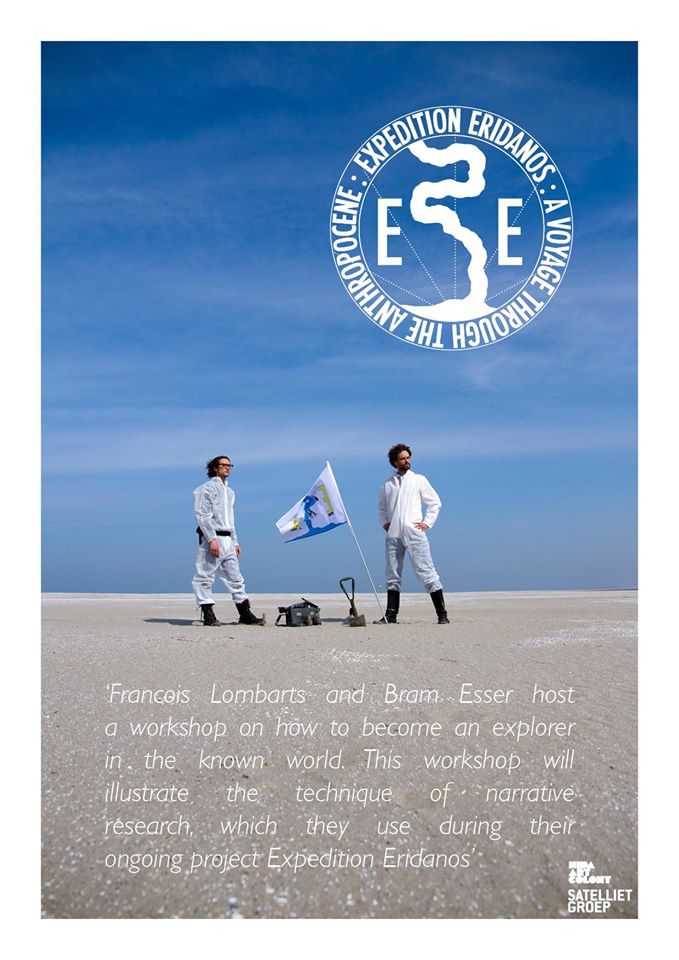
To Whom Belongs The Sea? @ Failed Architecture for TodaysArt2014
| 2014-10-10 09:46:29
TO WHOM BELONGS THE SEA? @ FAILED ARCHITECTURE
Date: September 24
Time: 16:30 - 18:30
Location: TodaysArt Festival at Zuiderstrandtheater, The Hague
Satellietgroep hosted Failed Architecture at Badgast. Curator Jacqueline Heerema joined Failed Architecture at TodaysArt Summit - Bright Collisions Program. During this edition of TodaysArt, Failed Architecture explores the defamed architecture and tourist infrastructure of Scheveningen and other Western European seaside towns, taking into account international and historical perspectives. Their aim is to open up new perspectives on the alleged failure of post-war seaside architecture - from what it's perceived to be, what's actually happening and how it's represented to the public.
More information: www.failedarchitecture.com/fa-at-todays-art-scheveningens-seaside-architecture/
To Whom Belongs The Sea? by Jacqueline Heerema
Soon the problems of beach resorts will be solved by climate change. With the prospect of a more wet and stormy climate tourism at the Dutch shores will become unattractive.
Time for change!
Artistic fieldwork
How incomprehensible is it to live in a country below sealeavel?
Understanding the Netherlands is basically understanding our relationship with water and the sea. Satellietgroep is based in The Hague since 2006 and explores through arts the social and ecological impact of the sea and coastal transitions on cities, people, communities and environments in The Netherlands and abroad. Satellietgroep invites artists, philosophers, designers, architect and urbanists to explore the sea and coastal transitions.
Oceans, seas and coastal regions are under tremendous pressure, worldwide.
What trigered the artists initiative Satellietgroep was the lack of involvement of arts and culture in the master plans for coastal transitions in The Netherlands, specially in The Hague, with top down masterplans for Scheveningen, Kijkduin, and the prospect of islands in front of the coast.
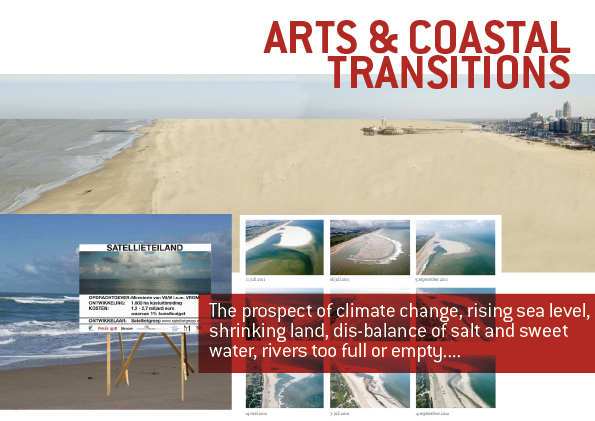
Spatial Planning North Sea 2050
With the prospect of climate change, rising sea level, shrinking land, dis-balance of salt and sweet water, rivers too full or empty, we face major coastal transitions. Transitions in spatial and economical sense that may lead to conflicts, estrangements, loss of heritage and loss of more informal cultural uses of public coastal space.
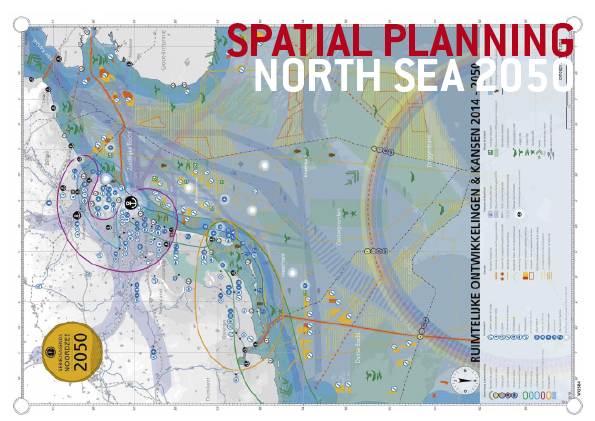
There is never one story to tell
We all live in the bubble of a Truman Show.
One day you wake up and realize what kind of world you live in.
Recently the dikes at Scheveningen turned into the dunes landscape it once was. So, lets talk about myths, appropriating the sea, manipulations, invented traditions and staged authenticity!
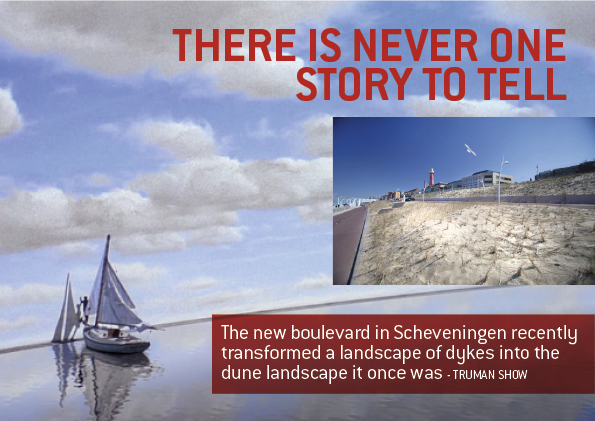
Theme park The Netherlands
Living in the Netherlands means living mostly in an artificial man-made environment. The Dutch are masters in disguising the cultural landscape as a natural one.
We tend to design, construct, reconstruct and deconstruct the coastal landscape to fit it to our needs. Like living in a theme park, pleasing to the eye without worries and full of leisure and endless entertainment.
In this picture the grandmother celebrates the first time she is playing with her grandson on the beach at Scheveningen. This picture tells a story about the Netherlands: the sand they play with is put there for coastal protection, the boulevard is a dike in boulevard for coastal protection, in the background the pier is a derelict remnant of former touristic venues competing with touristic destinations elsewhere and in the middle the Dutch flag completes the picture.
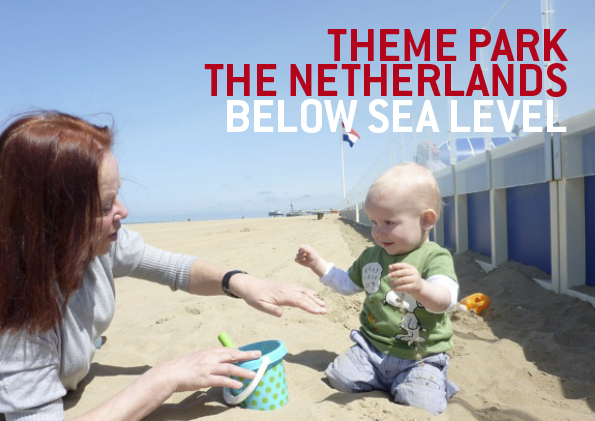
So, what happens elsewhere?
Belgium: parallel to the coastline
Every Belgian is said to be born with a brick in his stomach. Building your own house has shaped also the Belgian coastline. Developed as a sequenze of rectangular blocks of private housing along promenades it transformed with mass tourism into high rise apartment building catering for the Belgium dream to spend retirement at the seaside.
The good thing is, that a lot of people live at the coast and enjoy a private seaview, can travel along the coast by parallel tramway and eat (Dutch) mussles. The offsite is, that the Belgian coast is often called Atlantik Wall and dunes became scarce.
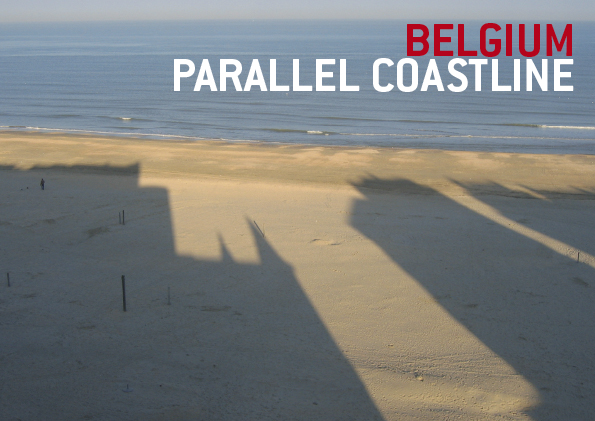
La Grande Motte: the paradox of mass tourism in a Tabula Rasa
After WOII the French goverment invented 'Droit a la Mer' - the social ideal based on the idea that a holiday on the seaside had to be democratized. More wealth, leisure and mobility for all made spending leisure time at the seaside accessible for everybody.
In a swamp area in the south of France a new and complete beach resort was designed by Jean Balladur with special architecture for mass tourism, influence by Oscar Niemeyer.
It was at first regarded as an ideal research area for new residential ideals, manufactured nature and innovative solutions for coastal expansion. At the same time the paradox of mass tourism arose: in search of paradise you find a composed touristic scenery.
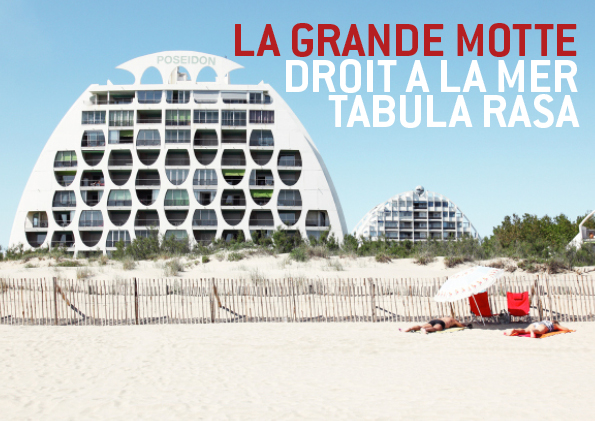
Orange County in Kemer, Turkey - copy paste architecture
Is search of the perfect touristic destination for the Dutch, including good weather and at the same time offering the familiar comfortable Amsterdam scenery, the all inclusive Turkish beach resort Orange County at Kemer was developed.
The advertisement reads: 'When you arrive at the hotel you will find yourself at the central station of Amsterdam, including Dutch information boards. Also striking are the Amsterdam canal houses complete with slanted walls. Also the well known windmill is not lacking. In short; a unique hotel with a Dutch twist under the Turkish sun.'
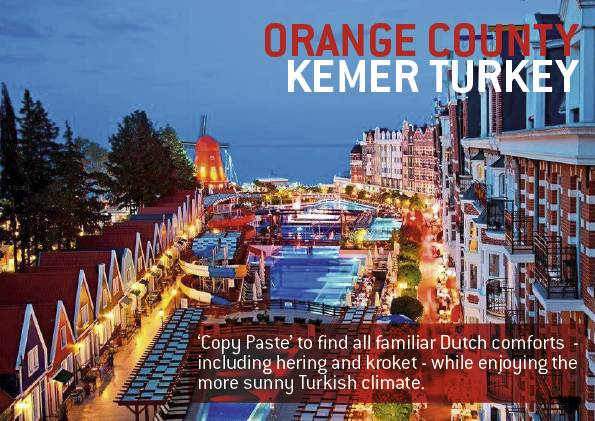
Lindoduin
In Scheveningen however, the high rise appartment building Lindoduin was built with a city view. Resilient people turned their bedrooms into the living room facing the sea.
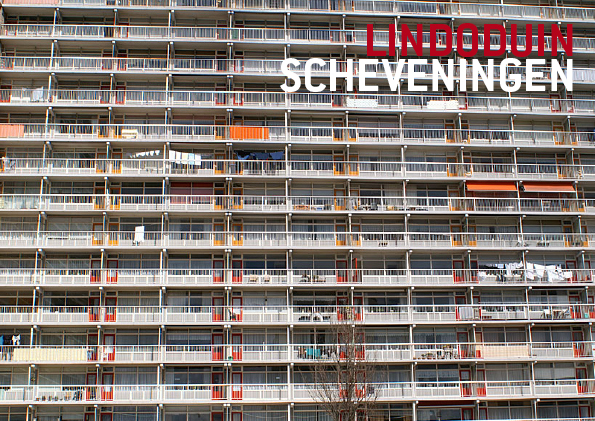
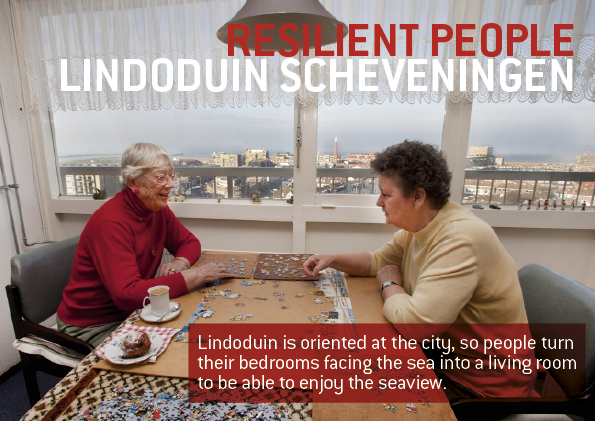
So, who decides what?
Zandmotor - Building with Nature
Understanding coastal architecture in The Netherlands implies understanding some of the Dutch history and the resilience of the Dutch landscape and people.
It is a layered landscape, showcasing the anthropogenic impact through ages: from building dikes and polders starting in the middle ages to fortresses, bunkers, harbours and (only) for the last 150 years beach resorts. It is a layered landscape to be viewed as a whole in stead of cutting it up in superimposed differences. The Dutch coastal landscape is not a Tabula Rasa!
Though we percieve and manipulate the coastal landscape as a natural landscapes of beaches and dunes it is in fact a cultural man made landscape. Coastal architecture reflects our relationship with water and the sea!
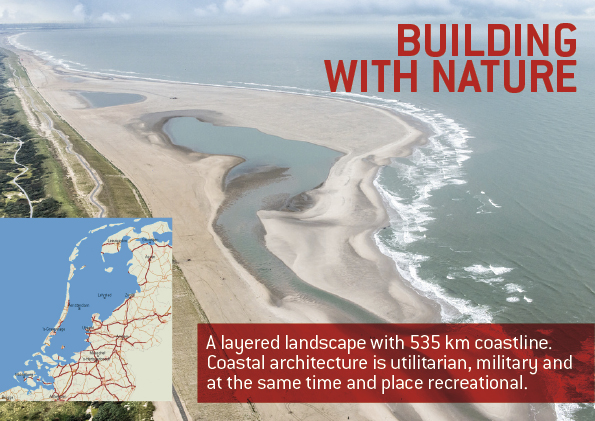
Delta Works
It is a resilient landscape, built to protect against the sea, built on fear of drowning and monsters. Hunter/gatherers migrated back and forth from the higher inland hills across the swamps to the dunes. Only poor people - like fisherman - lived precarious lifes in the dunes. Villages were swallowed by the sea mutiple times. Living in The Netherlands is a story about the liminality of coexistence between man and water. Safety is a big issue! In the latest Prinsjesdag budget 20 billion euro is designated for enforsing the dikes.
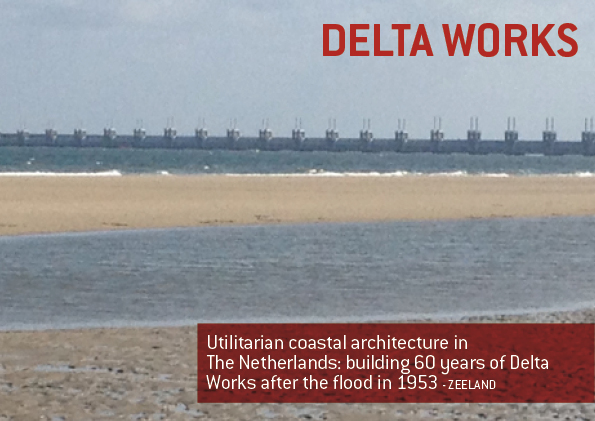
Bunkers
It is a hostile landscape, built to attack and defend, built to gain. Trade and war dominated the shores. Man is an explorer and invented cartography to chart the world and model reality and it’s myths. With the explorations of the sea for discovery of new countries and colonies, trading for goods, trafiking of people and cultures traders became rich and started hunting in the dunes, building boats and harbours. Wars left relicts and scars in the coastal landscape.
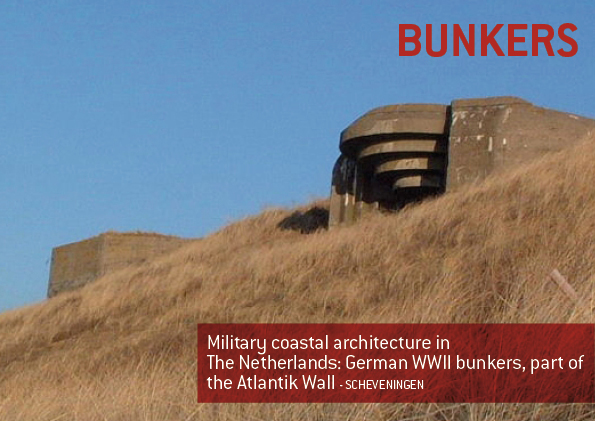
Tourism
Starting around 1800 the perception of the coast shifted to a landscape for wellness with tourists in seach of paradise. The coastal landscape became an imaginairy construction with the rise of Kurhauses, boulevards and casino's for the happy rich. Sea view became valuable. Mass tourism turned the shore into a commercial landscape in which beaches are more and more converted into private enterprises.
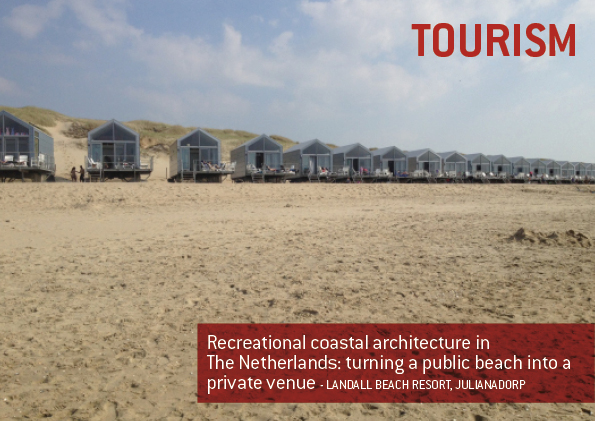
People in Scheveningen are born with sand between their teeth
However - it is a landscape to express your identity, that you are different! Even through invented traditions and staged authenticity!
Once a fishing village swallowed by the city The Hague there is still a vibrant Scheveningen identity. Even the construction of identity is appreciated. When in the fifties an economic impuls was needed for the declining fishing industry, the municipality of The Hague invented 'Vlaggetjesdag', a special day to celebrate the new herring. In search of branding they adopted the wapon of an extinct family at Hoorn or Enkhuizen: the 3 herrings! It became broadly adopted by the Schevening people as their logo and is recently even stamped into the garbage cans at the new boulevard of Scheveningen.
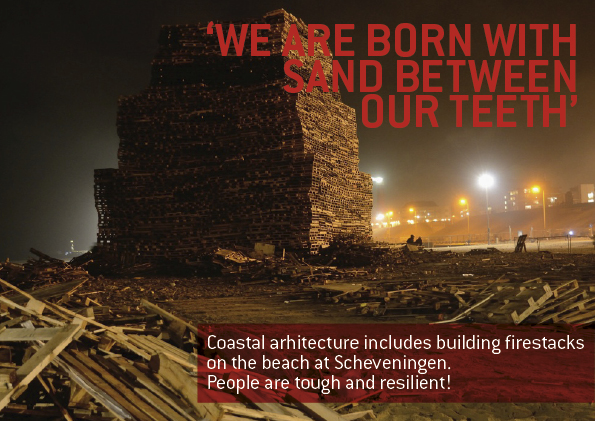
Badgast
In the most multi layered spot on the shores of the Netherlands Satellietgroep built Badgast. Scheveningen has all the stories to tell, including the myth of free horizon - and the illusion of the seaside as a place of mental and physical freedom, as a place to marry and mourn.
A cultural zenith! Badgast is built by recycle architects Refunc in the middle of urban beach community F.A.S.T. at the pivot point of boulevard and harbour. Built on top of a WOII bunker. Wedged between 2 fish and chips shops. Built on a derilict plot as an 'in between' adventure, instigated by reccession and (still) waiting for the highrise hotel to be built on the spot.
I love planning and politics! They shape - again and again - worlds beyond our imagination.
They seem to forget that Scheveningen is not shaped into 3 superimposed categories of Bath, Village or Harbour, but it is a layered coastal landscape, including residents and visitors.
Over and over residents combat superimposed changes, and alliances arise between fishermen and rich folks. It may be time to listen?
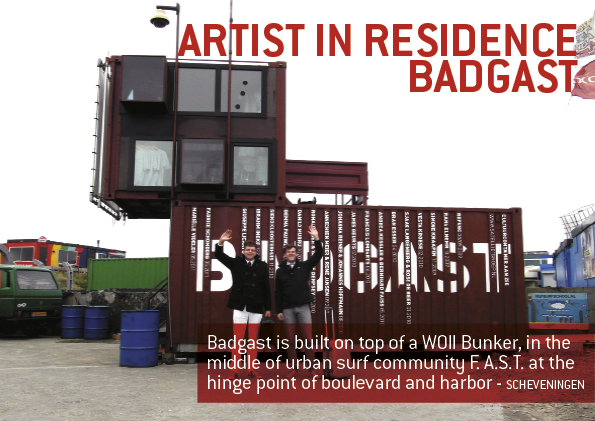
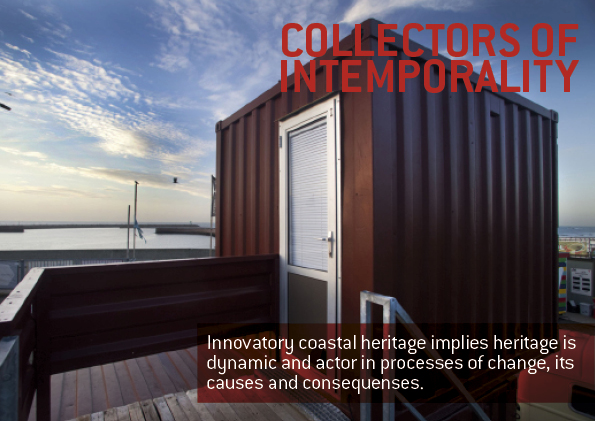
Resilience
I remember as a child that the Kurhaus was boarded up and destined to be demolished. Recently it just escaped bankrupcy again. The pier is closed for public as a result of the battle between the city municipality and Van der Valk family. The habour is turned into a Marina, where new residents in recreation houses complain about the noise and smell of the fishing boats. The Hague people do not go to Scheveningen and resist tourism spreading across the harbour. The Norfolkterrain itself was designated for culture, became a battle ground for competing ideas, but now, after the failure of the Spuiforum, now finally the terrain opens up for culture!
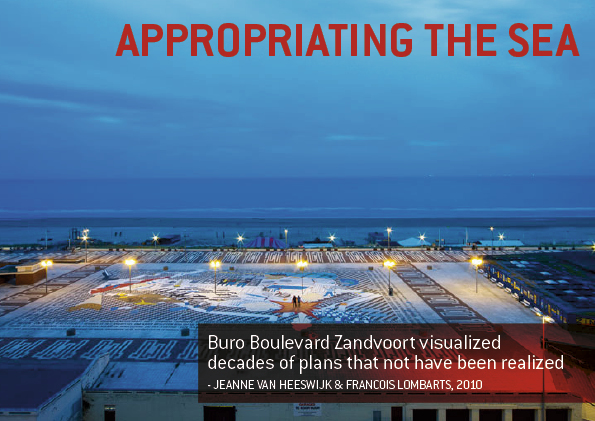
Appropriating the Sea
There is never one story to tell: the myths of coastal planning!
Buro Boulevard Zandvoort was a cooperative project by Jeanne van Heeswijk and Francois Lombarts. At the Burgemeester van Fenema square next to the boulevard of Zandvoort they set up a design studio. From this location they researched all the plans for the area that have been made over the years. Decades of plans that not have been realised. They also investigated the current needs and ideas of the inhabitants and visitors of Zandvoort.
The outcome of these researches where combined in order to create a big artist impression of all the drawings, plans, ideas and impressions that where made for this seaside area. With a team of street painters a huge drawing was painted on the square. It combined quotations from the many reports and municipal development plans with impressions from ideas for the area. All functions that the location could have had, but for various reasons still does not seem to have.
Thank you for your attention!
Honorary Award ISea - Clash of the Concepts
| 2014-09-03 15:37:56
JUNE 13, Pakhuis de Zwijger Amsterdam:
During ISea - Clash of the Concepts, organized by Rijkswaterstaat Satellietgroep was honorary awarded for the concept of Badgast2.0!
Lezing, videos & Locals Only#1 tijdens Noordzeecongres 2014
| 2014-02-27 15:35:36
LEZING 'INNOVERENDE KUSTCULTUUR' TIJDENS NOORDZEECONGRES 2014
13 maart 2014 in het Provinciehuis Zuid-Holland, Den Haag
Organisatie Ministerie I&M
Minister Melanie Schultz van Haegen opent het Noordzeecongres. Prinses Laurentien presenteert de Raad van Kinderen van de RKBS De Paradijsvogel. Zij adviseren de opstellers van de Gebiedsagenda Noordzee 2050.
Wat staat ons de komende jaren te wachten met de opgave voor duurzame energie? Hoe willen we de Noordzee van de toekomst zien? Welke mogelijkheden zijn er voor innovatie en meervoudig ruimtegebruik? En hoe kunnen we de komende decennia, door intelligent en constructief samen te werken, de Noordzee op duurzame wijze maatschappelijk en economisch nóg rendabeler maken? In de Noordzee 2050 gebiedsagenda worden de kansen en mogelijkheden in kaart gebracht die de Nederlandse Noordzee biedt om bij te dragen aan maatschappelijke behoeften van de mensen op land. Daarvoor wordt de potentie van de zee in beeld gebracht op het gebied van voedsel, beleving, energie en bereikbaarheid. Naast onderzoek naar trends en ontwikkelingen in gebruiksfuncties, zoeken we vooral naar innovatieve kansen op zee, kansen op samenwerking tussen (top)sectoren, maatschappelijke organisaties, kennisinstellingen en overheden en vooral naar de verhalen daarachter.
Tijdens dit Noordzeecongres gaf Jacqueline Heerema - curator/founding director van Satellietgroep - de lezing geven over 'Innoverende Kustcultuur'.
De relatie mens en natuur verschuift en vraagt om nieuwe benaderingen. In Nederland hebben we een sterke relatie met water en de zee, maar dat is niet voor iedereen zichtbaar. De zee, duinen en kust spelen een steeds grotere rol in hoe we samen met de natuur in de toekomst onze leefomgeving gezond kunnen houden.
Nieuwe culturele en educatieve programma’s bieden mensen de mogelijkheid zich te positioneren en te (leren) verhouden tot kustontwikkelingen die van invloed zijn op hun leefomgeving. Communicatie en educatie zijn de maatschappelijk speerpunten voor duurzame ontwikkeling van de Noordzee, de kust en kustbescherming. Betrokken overheden en organisaties onderkennen het belang van gedeelde kustagenda’s en het belang van kunst en cultuur in deze ontwikkeling. Satellietgroep is partner in deze processen: in samenwerking met betrokken kustorganisaties, kustgemeenschappen en wetenschappers ontwikkelt Satellietgroep artistiek onderzoek, kunstproducties en openbare presentaties die zich richten op het vergroten van publiek bewustzijn en betrokkenheid bij kustontwikkelingen.

'Hemels Gewelf' James Turrell en Zandmotor, Kijkduin.
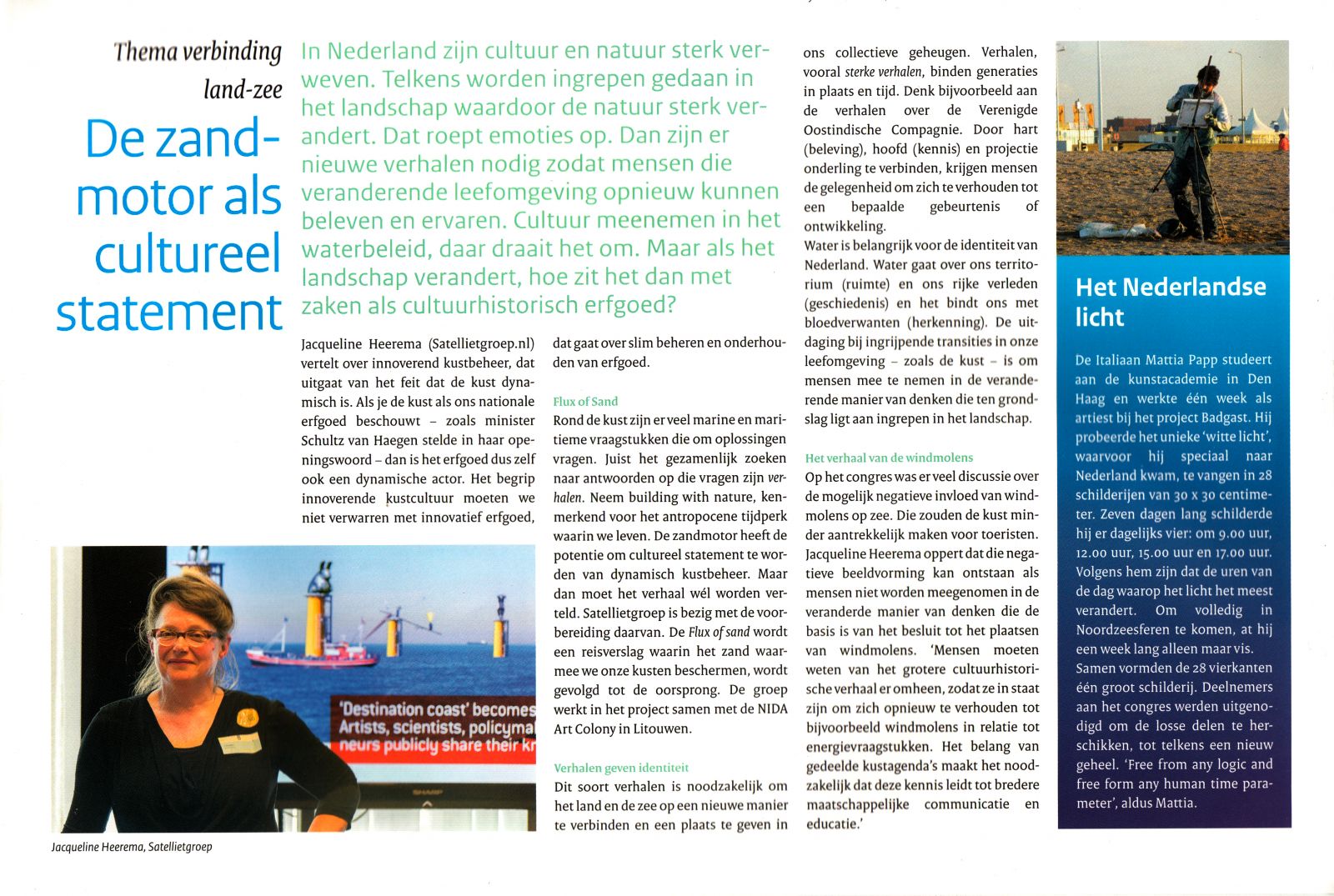
Noordzee Congres publicatie: 'De Zandmotor is het nieuwste exportproduct van kennis en watermangement van Nederland en tevens het grootste actuele culturele statement ten aanzien van de verschuiving van de relatie mens en natuur.'
CINEMA AT SEA DURING NORTH SEA CONFERENCE:
A selection of videoworks produced by artisst in residencies at Scheveningen, Turkey, Georgia and Moldova or during 'Stellingname' is presented.
For more films please contact: satellietgroep@gmail.com
1. Connecting arts with coastal protections:
'Zeelust – Kustweek Zuid-Holland' 4:19 min (2013)
Video documentation by Suzi Colpa of the artistic intervention by artist Hugo Schuitemaker during the interactive coastal program ‘Zeelust’ by Satellietgroep. During ‘Zeelust’ arts and future coastal scenarios 2050-2100 by Atelier Kustkwaliteit (Deltaprogramma Kust /TU Delft) connected in a public and professional program. During the program of ‘Zeelust’ the national coastal debate took place. The artistic intervention consisted of a waterbassin and collaboration by the guests of the debate was essential to be able to cross this barrier of water.
2. Coastal protection and oral history:
'Departure Bay' 9:13 min (2011) by Aram Tanis (South Korea/NL) & Jacolijn Verhoef (NL)
Videowork produced while artists in residency of ‘Badgast’ of Satellietgroep at Schevenngen.
Tanis and Verhoef created the short narrative documentary ‘Departure Bay’ in Scheveningen and Zeeland. Tanis’ dad experienced as a child the floods of 1953 and remembers conflicting emotions. In the context of large scale developments for coastal protection this is a particular interesting document, because this flood disaster instigated 60 years of Delta Works, which have recently been completed. The latest innovation in this area is the Sand Engine. Both Tanis and Verhoef live in the city. They discovered while artists in resedence at Badgast, with a frontal daily view on the sea, wind, rain and smell, that the sea influenced their way of observation and thus influenced the documentary.
3. Challenges of the Netherlands: the sea is rising, the land is shrinking, disbalance of salt and sweet water and saline land with rivers too full of empty:
'Sinking into the Landscape' 11:28 min. (2013) by Francois Lombarts (South Africa/NL)
Produced during ‘Stellingname – water, land and innovatory heritage’ curated by Satellietgroep for Kunstfort bij Vijfhuizen. 'Sinking into the Landscape' is a voyage through the waters of the Haarlemmermeer polder. In this polder all watercycles of The Netherlands come together. By swimming through the canals, ditches and trenches Lombarts visualizes the physical experience of the polder as an attempt to understand the idea of living below the sea level and being submerged in a water landscape.
4. Social aspects of living on the shores:
‘Refugium’ 7:30 (2013) by Henrik Lund Jørgensen (Denmark/Sweden)
Videowork produced while artist in residency of ‘Badgast’ of Satellietgroep at Scheveningen.
As in his previous work this videowork is viewed in the light of themes as ethnicity and belonging. The work evolves around the relationship between a picture or photograph and the physical distance to where it was taken. During his residency Henrik Lund Jørgensen collected pictures and stories from Scheveningen and The Hague. When he returned to Sweden, it dawned on him that he could use these images and stories in a way that could be explained by the feeling you have after you have been on a vacation. The uncertainty regarding what you have experienced or what are imagined experiences.
5. Connecting the North Sea to other seas:
‘North Sea Transport’ 4:15 min (2014) by Maarten de Kroon (NL)
Videowork produced by award winning filmmaker Maarten de Kroon (Dutch Light, V.I.S.S.E.N.) during the international artist in residency exhange project ‘Now Wakes The Sea’ by Satellietgroep and MediArt Dialogue in Moldova. This short video is inspired by an early work of Dutch artist Wim T. Schippers. The Netherlands are located along the North Sea, Moldova is (became) a landlocked country. After the collapse of the Sovjet Union the country lost it’s direct access to the Black Sea. Maarten de Kroon also produced in Moldova ‘Landlocked’ (39 min) a documentary film about the relation between Moldova and the Black Sea. Moldova is a landlocked country. During ages Moldova had and didn’t have direct access to the Black Sea. History gives and takes. Moldova was temporarily a state on it’s own, part of the bigger Roman Empire, Dacia, Romania, the Ottoman Empire, Russia and the Sovjet Union.
INTERACTIVE PERFORMANCE TWENTY EIGHT LIGHTS (2014)
BY 'LOCALS ONLY#1' MATTIA PAPP DURING NORTH SEA CONFERENCE:
First year student Fine Arts at Royal Academy of Arts in The Hague is Mattia Papp. He was for 1 week artist in residence of ‘Badgast’ by Satellietgroep as part of the program ‘Locals Only’.
Guests are invited to rearrange the canvasses. The new arrangement will be photographed. The photo will be send by email.
Mattia: "Hi, my name is Mattia Papp, I’m a painter.
I was born in Florence twenty years ago, raised up there, surrounded by renaissance masters, classical beauty and an astonishing yellow light. I spent my summers at Elba’s island, in Tuscany, blue sea, warm climate and more yellow light. Two years ago it was enough, I wasn’t able to handle it anymore, I had to move.
I came here in Holland to study art at the KABK in Den Haag, searching for a new mood. Something more rational, colder and more contemporary. Searching for the same love that moved Vermeer. I needed these new things. I needed the white light of Netherlands, a light that tells the truth, colors as they are without any filters. Nor the warm filter from Mediterranean sea, neither the blue grey one from Germany and England.
My project at 'Badgast' was about this Dutch light, the wind and the black and grey Nordic sea.
I made four canvasses per day for one week. One at 9 o’ clock in the morning, one at 12:00, one at 15:00 and one at 17:00. These are the hours of the day where the light changes in the most significant way. Also by following a diet of fish, I’ve been able to totally immerge myself in the Nordic sea atmosphere. I worked on this project with discipline and strict attitude.
The result consists of twenty-eight canvases (30X30cm), assembled as one piece, not organized and not following the order of production of the single pieces. It represents one unique sea landscape (120 cm X 240 cm): the Scheveningen sea shore. Each of the canvases is independent, as independent is this white light, immortal, the symbol of a mayor inspiration that I’m desperately looking for.
In fact the viewer is able to switch the canvases of the opera as he or she wants, as he or she feels like. Free from any logic and free from any human time parameter.
I just wanted to capture the light and not the scenery in this work.
Just the light."
Mattia working at Scheveningen beach.
Seminar 'Shifting AiR Strategies' Dec 14, Delft
| 2013-12-03 12:20:05
DutchCulture | TransArtists organizes with id11, Satellietgroep, and Wander the Seminar 'Shifting AiR Strategies' in the framework of 'CreArt' Network of Cities for Artistic Creation and 'Mutual Artist-in-Residence Impulse' Russia-Netherlands.
Thousands of artists apply and are hosted by more than 1200 Artist in Residency (AiR) organizations around the world each year. In The Netherlands are currently 77 AiR organizations listed.
What are the current aims and positions of AiR programs? And what do the AiR organizations do with the outcomes - objects and/or knowledge - of the hosted artists?
Join the seminar 'Shifting AiR Strategies' with AiR organizations from The Netherlands, Europe and Russia, to share your ideas and connect to the latest insights and strategies.
Artist-in-Residence is a changing phenomenon. Hosts and guests reinvent the ways they operate due to shifts in economics, politics and cultural circumstances. Some opt for interdisciplinary research, others for integrating artistic goals with social or commercial activities.
The program is warmly recommended to artists, artist in residency organizations, theorists, entrepreneurs, funding organizations, policymakers and activists.
Saturday December 14th: 10.00 – 20.30
Location: Lijm & Cultuur, Rotterdamseweg 272, 2628 AT Delft, The Netherlands
Registration: by e-mail to info@id11.nl before December 10, 2013
Admission is free. Costs for drinks and food during the whole day is € 32.50 per person.
www.id11.nl | www.transartists.org | www.satellietgroep.nl | www.go-wander.org
Moderator of the day is Floor van Spaendonck, manager Platform bij Het Nieuwe Instituut.
The program includes the sketch of ‘Profiles and Practices’ in the international field of AiR by Janwillem Schrofer, organizational sociologist and former president Rijksakademie Amsterdamormer director of Rijksacademie and special contributions by artists Kosta Tonev, Anna Moreno, Anne Breure, currently residents of Wander in The Hague.
During the seminar Jacqueline Heerema, curator of Satellietgroep will moderate the session on 'Collecting - what do you do with the results of your AiR program (objects or knowledge)?' together with Leontine Meijer van Mensch. She is lecturer of heritage theory and professional ethics at the Reinwardt Academy (Amsterdam) and president of COMCOL - the international committee of ICOM (International Council of Museums) with the mission to deepen discussions and share knowledge on the practice, theory and ethics of collecting and collections (both tangible and intangible) development.



